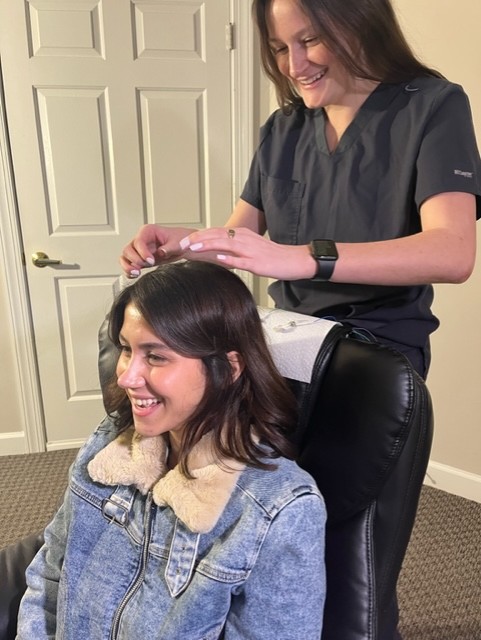Neurofeedback therapy, a non-invasive brain training method, has promising literature showing the relief of symptoms in individuals grappling with chemotherapy-induced peripheral neuropathy (CIPN)—a challenging and often debilitating condition. CIPN arises as a side effect of chemotherapy, a common cancer treatment, and affects the nervous system, leading to a range of symptoms that can significantly hinder a person’s daily life. Patients may experience a myriad of discomforts, from tingling and numbness to severe pain and muscle weakness in their extremities, impacting their ability to perform everyday tasks and severely diminishing their quality of life.
The search for effective treatments for CIPN has been ongoing, with limited success in finding solutions that can alleviate the symptoms without additional side effects. Recent studies have shed light on the effectiveness of neurofeedback therapy, offering a scientific basis for its application in treating neuropathy symptoms. These investigations delve into how neurofeedback can not only reduce the discomfort associated with chemotherapy-induced peripheral neuropathy but also enhance patients’ overall well-being and functionality. As we explore the benefits of neurofeedback therapy for CIPN, it’s crucial to consider these studies as a cornerstone of understanding—highlighting the therapy’s potential to transform lives without the need for additional medication.
Breaking down CIPN
Chemotherapy-Induced Peripheral Neuropathy presents a complex challenge for countless cancer survivors, manifesting through a trio of distressing symptoms: pain, numbness, and weakness. The prevalence of CIPN is a significant concern, with a notable percentage of patients undergoing chemotherapy experiencing these nerve-damage symptoms, sometimes persisting long after treatment has concluded. This enduring impact underscores a critical gap in current medical care—the stark lack of effective treatments for CIPN. Traditional approaches often fall short, leaving patients in a continual search for relief. This gap in care highlights an urgent need for innovative solutions that can address the multifaceted challenges of CIPN, making the exploration of alternatives like neurofeedback therapy not just desirable but necessary for improving the quality of life among cancer survivors.
Insight from the research on Neurofeedback for Chemotherapy-Induced Peripheral Neuropathy
In the study titled “The Long-Term Impact of Neurofeedback on Symptom Burden and Interference in Patients With Chronic Chemotherapy-Induced Neuropathy: Analysis of a Randomized Controlled Trial,” researchers explored the efficacy of neurofeedback therapy in alleviating the debilitating symptoms of CIPN. This research revealed that patients undergoing neurofeedback experienced significant reductions in symptoms such as pain, numbness, and weakness, leading to an improved quality of life. The methodology of the study was meticulously designed to ensure reliability and validity: participants were carefully selected based on specific criteria to accurately represent individuals suffering from chronic CIPN. The treatment protocol involved regular neurofeedback sessions, while the assessment of outcomes utilized a variety of tools to measure symptom burden and interference. These key findings show the potential of neurofeedback as a powerful intervention for those enduring the long-term effects of chemotherapy-induced neuropathy, offering an option for effective management and improved patient outcomes.
Another piece of literature, “Randomized Controlled Trial of Neurofeedback on Chemotherapy-Induced Peripheral Neuropathy: A Pilot Study” serves as another critical exploration into the capabilities of neurofeedback therapy for managing the symptoms of CIPN. Results from this exploratory study were promising, indicating that participants who received neurofeedback therapy reported noticeable improvements in managing their CIPN symptoms, including reductions in pain and discomfort. The study’s outcomes are compelling, suggesting that neurofeedback holds potential as a novel approach to alleviating the burdensome symptoms of chemotherapy-induced neuropathy and warrants further investigation in larger, more comprehensive trials.
Both investigations underscore neurofeedback’s efficacy in symptom management, revealing consistent findings that patients experienced significant relief from the pain, numbness, and weakness characteristic of CIPN. Together, these studies contribute significantly to the evolving landscape of CIPN treatment, marking neurofeedback therapy as a potentially vital addition to the repertoire of interventions aimed at enhancing the well-being of those affected by chemotherapy’s nerve-damaging effects.
Patient Experiences
The transformative power of neurofeedback therapy for those suffering from chemotherapy-induced peripheral neuropathy (CIPN) becomes clear through the personal stories of patients who have undergone this treatment. While the clinical studies provide a foundation of evidence for neurofeedback’s efficacy, it’s the firsthand accounts that truly bring the statistics to life. For instance, patients have shared remarkable testimonials about their journey with neurofeedback, recounting how they moved from debilitating symptoms of pain, numbness, and weakness to significant improvements in their daily lives. Such stories emphasize the profound impact neurofeedback therapy can have, highlighting its potential as a pathway to reclaiming a sense of well-being after the rigors of chemotherapy.
It is evident that this approach represents a pathway toward alleviating the profound discomfort and disruption brought on by this condition. Addressing the peripheral neuropathies that linger after cancer treatment is crucial to every survivor living a full life free from the shadows of pain and limitation. Through meticulous research and heartfelt patient testimonials, we’ve seen how neurofeedback can significantly diminish the symptoms of CIPN, empowering patients to reclaim aspects of their daily lives that were once overshadowed by pain.





